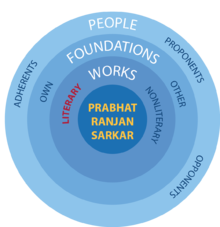User:Sharala/sandbox: Difference between revisions
No edit summary |
No edit summary |
||
| Line 17: | Line 17: | ||
== Synopsis == | == Synopsis == | ||
{{Quote box|width=360px|bgcolor=|align=left|quoted=1|salign=right|quote= | {{Quote box|width=360px|bgcolor=|align=left|quoted=1|salign=right|quote=SThe Giitá is the call, the Giitá is the clarion call, of the Supreme;(2) the Giitá is the clarion call of the Supreme Guide. Yá Bhagavatá giitá sá Giitá. Now, it is the divine call. Now, let us see what is its spirit. The spirit of the Giitá is that one should march, one should move, towards one’s spiritual goal, by making proper adjustment between inner urge and external physicalities. But you know, the external mundanity always tries to deprave a sádhaka, so he will have to fight a ceaseless battle against these depraving factors. In the Giitá, it is the order of Bhagaván to fight against depraving factors, to fight against inner and outer enemies.]|source=Shrii Shrii Anandamurti}} | ||
Anandamurti starts the discourse by explaining the word Bhagavan. Bhagavan means the possessor of six occult powers: occult power, stamina, reputation, charm, spiritual knowledge and renunciation. Anandamurti then says that the Giita is the expression of Bhagavan and its spirit is to fight against all depraving forces external and internal and come up victorious reaching the Supreme goal of self realization. Anandamurti goes on explaining an important verse describing that spirit: Dhrtaráśt́ra uváca: | |||
Dharmakśetre Kurukśetre samavetá yuyutsavah; | |||
Anandamurti starts the discourse by | Mámakáh Páńd́aváshcaeva kimakurvata Saiṋjaya? | ||
The bottle goes on in the mind between an hundred tendencies pulling it downward and five internal centers aiding it towards divinity. This bottle goes on until the mind is conquered and the sadhaka is victorious.<ref name="AV34"/> | |||
== References == | == References == | ||
Revision as of 15:03, 1 March 2018
| One Will Have to Know Oneself | |
|---|---|
| Speaker | Shrii Shrii Anandamurti |
| Date | unknown |
| Language | English |
| Topic | The importance of our Ista mantra in acquiring self knowledge |
| Included in | Ananda Vacanamrtam Part 34 |
| Location in Sarkarverse | |
One Will Have to Know Oneself is a discourse given by Shrii Shrii Anandamurti. This discourse is the eleventh chapter of Ananda Vacanamrtam Part 34.[1]
Synopsis
SThe Giitá is the call, the Giitá is the clarion call, of the Supreme;(2) the Giitá is the clarion call of the Supreme Guide. Yá Bhagavatá giitá sá Giitá. Now, it is the divine call. Now, let us see what is its spirit. The spirit of the Giitá is that one should march, one should move, towards one’s spiritual goal, by making proper adjustment between inner urge and external physicalities. But you know, the external mundanity always tries to deprave a sádhaka, so he will have to fight a ceaseless battle against these depraving factors. In the Giitá, it is the order of Bhagaván to fight against depraving factors, to fight against inner and outer enemies.]
Anandamurti starts the discourse by explaining the word Bhagavan. Bhagavan means the possessor of six occult powers: occult power, stamina, reputation, charm, spiritual knowledge and renunciation. Anandamurti then says that the Giita is the expression of Bhagavan and its spirit is to fight against all depraving forces external and internal and come up victorious reaching the Supreme goal of self realization. Anandamurti goes on explaining an important verse describing that spirit: Dhrtaráśt́ra uváca: Dharmakśetre Kurukśetre samavetá yuyutsavah; Mámakáh Páńd́aváshcaeva kimakurvata Saiṋjaya? The bottle goes on in the mind between an hundred tendencies pulling it downward and five internal centers aiding it towards divinity. This bottle goes on until the mind is conquered and the sadhaka is victorious.[1]
References
| Preceded by Gáyattrii Rhythm and the “Gáyattrii Mantra” |
Ananda Vacanamrtam Part 34 With: One Will Have to Know Oneself |
Succeeded by Blind Mind and Conscience |
